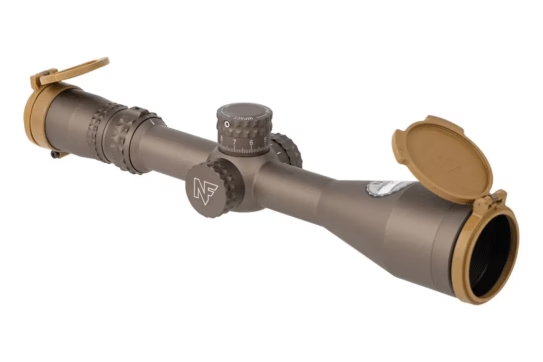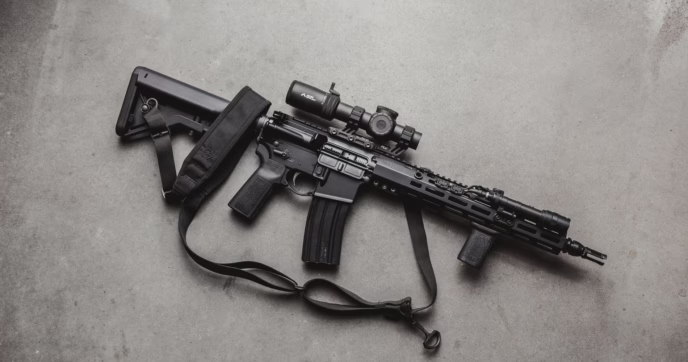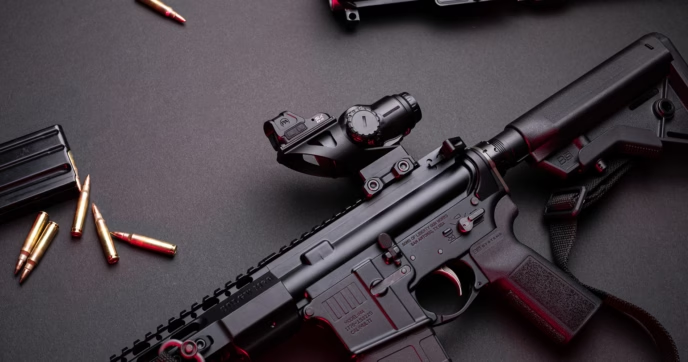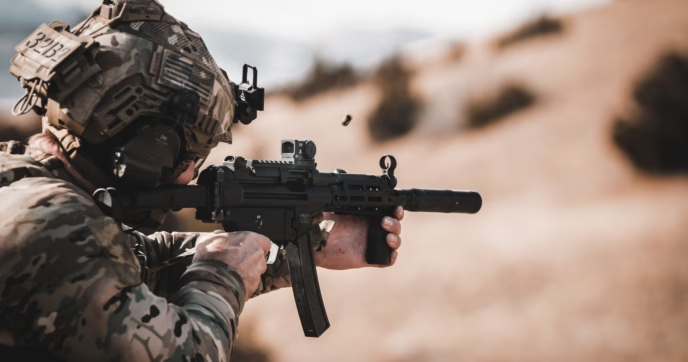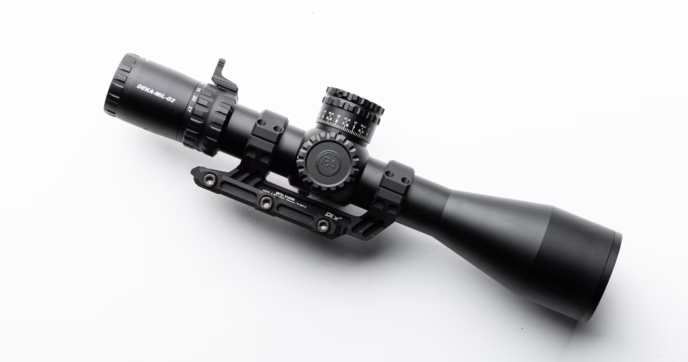With big game season approaching, enthusiasts nationwide are preparing for opening day. For many, however, this may be the very first time they’ve ever hunted big game—and if you’re reading this, this either your first season as well, or you’re looking to upgrade your rifle’s optic before you head out.
Regardless of what brought you here, whenever the topic of big game hunting comes up, the topic of the best optic for the job isn’t too far behind it. And with the optics industry staying in a near-constant state of innovation, there’s almost always new rifle scopes with new features and innovations, no matter what time of year you shop.
Whether you aim to bag an Elk, Deer, Pronghorn, or any other big game in your area, your chances of having a successful hunt are greatly increased when you have the right optic. So, to kick off the hunting season right, part one of this three-part series will be focusing on the best hunting scopes for big game.
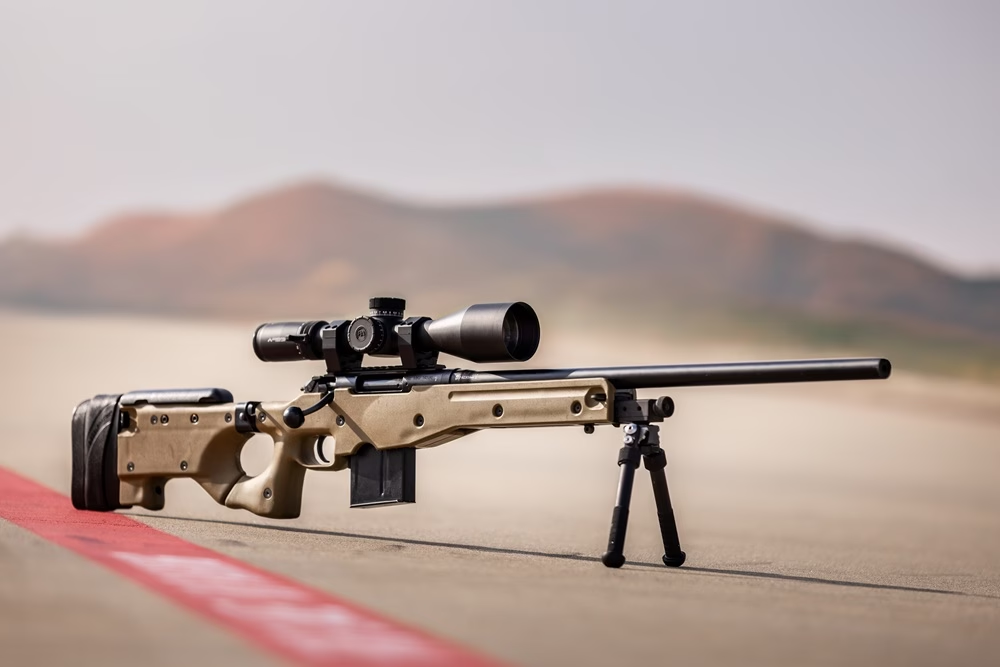
Why Optics Matter when Big Game Hunting
Of all the applications long-guns are used for, hunting is one of the most popular, and a core belief held by basically all sharpshooters is the idea that having the right optic goes a long way in ensuring success. Before magnified optics became the norm, users relied on rudimentary iron sights for aiming. While they aren’t by any means, as your distance-to-target increases, their overall utility decreases. And this is precisely where rifle scopes come into play.
Although variable power optics can differ in design, size, and function, they all share a key advantage over iron sights: they can magnify your target picture. With a higher magnification level, you can get a much clearer picture of your target, giving you the ability to see both it and its surroundings more clearly.
Depending on the type of optic you look at, the magnification range can vary. For instance, Low-Power Variable Optics, better known as LPVOs, typically have either a 1-6x, 1-8x, or 1-10x magnification, and when you step up to Medium- and High-Power Variable Optics (MPVOs and HPVOs), they can have anywhere from a 4-16x magnification range to as much as 5-25x or 6-30x one. Each type of rifle scope has its own distinct advantages, but we’ll highlight them later below
Another key advantage rifles have over irons is their reticle systems. Iron sights give you a single reference point for aim, and while specialized ones can be adjusted for range, they still leave something to be desired when shooting at long-range. Nowadays, rifle scopes are capable of housing incredibly complex reticle systems that provide ranging data and other tools like moving target leads. And by opting for more advanced BDC, MOA, or MIL based reticles, you can easily engage targets out to around 800 to even 1000+ yards, depending on the optic.
Factors to Consider When Choosing a Hunting Scope
It’s worth pointing out that choosing hunting optics sounds like a simple task on paper, but with there being so many options to choose from, it’s easy to get overwhelmed. As such, whenever you’re looking for a dedicated hunting scope, there’s three main things to consider when selecting an optic: its magnification range, reticle, and its overall durability.
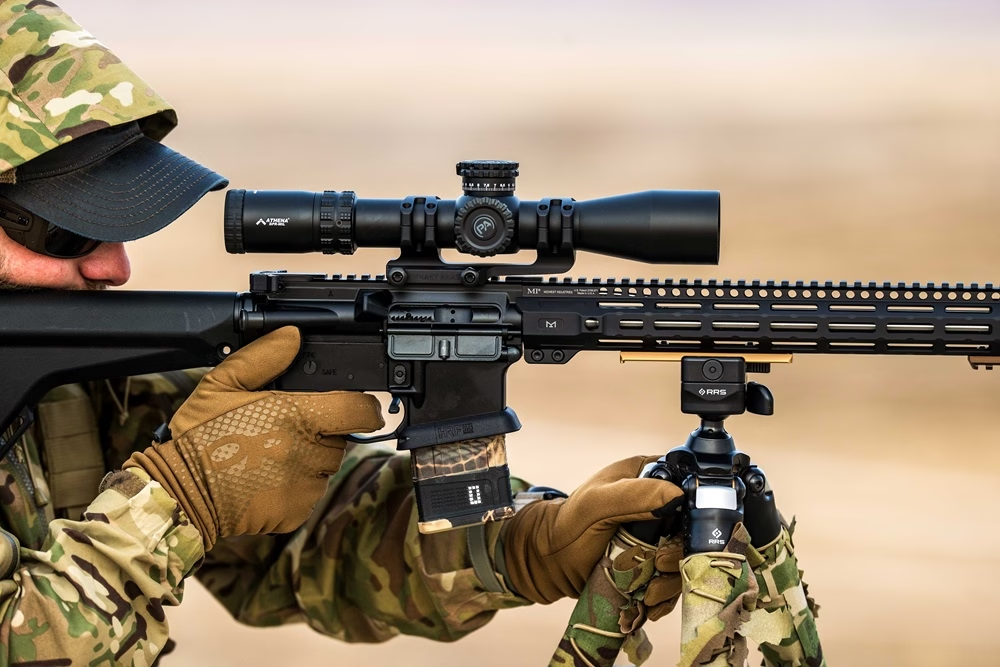
Magnification
Magnification is one of the core reasons variable power optics are so popular for hunting. However, the total range of magnification can vary depending on the optic. Because of this, choosing the optimal magnification range for you is going to depend heavily on the area you’ll be hunting in, as well as your expected distance-to-target.
As you’d likely expect, the average distance-to-target varies greatly depending on where exactly you’re hunting. In states/areas where there’s more hills, mountains, and valleys with dense forests, the average shot distance can be as close as 15 to 50+ yards or as far as around 150 yards. In contrast, areas with flatter expanses, like the Midwest and most of Texas, your distance-to-target can easily be upwards of 200 yards, although it’s possible to be upwards of 600+ yards away. As such, you’ll need to make sure that your optic is powerful enough to match whatever range you plan on hunting at.
An easy way to figure out an optic’s magnification range is by looking at the three number string accompanied by its model name. For example, the Primary Arms Optics SLx® 3-18×50 FFP Gen II Rifle Scope can be adjusted anywhere from 3x to 18x magnification, as denoted by the “3-18x” in its name. Regardless, if you already know that you’ll be hunting large game at distances beyond 250 to 300+ yards, we recommend checking out our guide on Long Range Hunting Gear, to best set yourself up for success before heading out to the field.
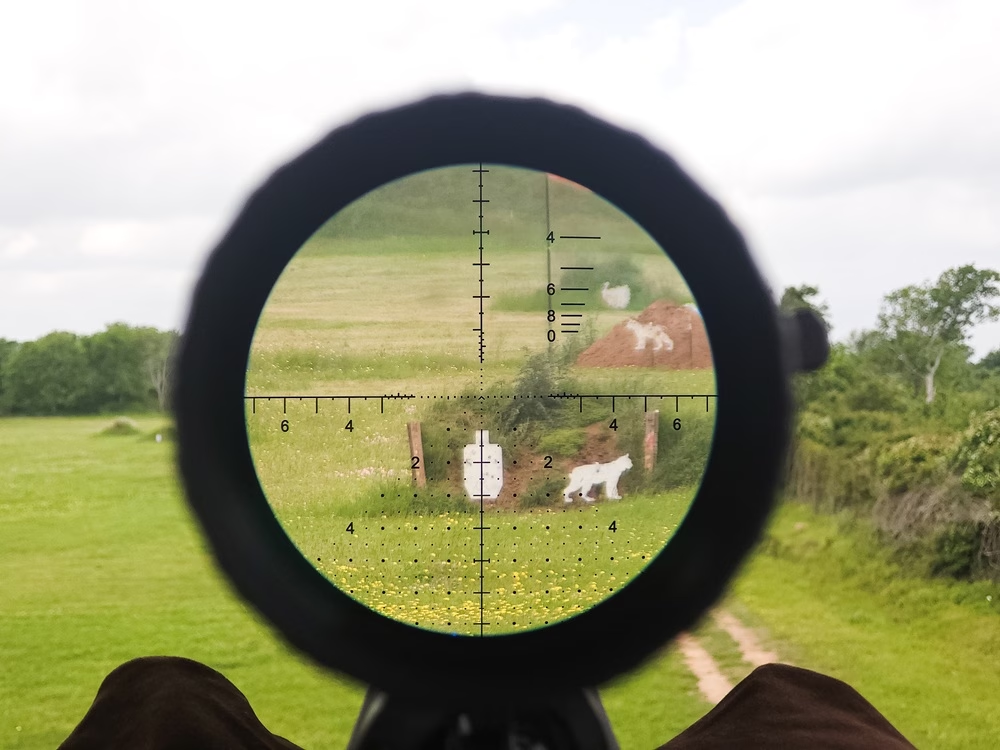
Reticle Choice
As we mentioned earlier, the reticle your optic houses can have a profound effect on your ability to make precise shots at distance. It’s common for newcomers to think that all they need is a basic wire or duplex reticle for hunting, and while they can certainly be effective, they don’t offer the most in terms of long-range versatility. And this is where modern optics with complex reticles come into play.
We briefly spoke of this above, but modern optics are capable of housing incredibly complex reticle systems that can include an assortment of windage holds, bullet drop compensation/ranging stadia, and even full MOA or MIL grids for more complex holds at distance. We have an entire article that goes in-depth on the intricacies of MOA, MIL, and BDC reticles, and we recommend giving it a read to get up to speed on each reticle type’s strengths and weaknesses.
To briefly summarize them, MOA stands for “minutes of angle” which is an angular measurement in which, at 100 yards, 1 MOA represents 1.047 inches. By rounding that down slightly, MOA reticles work exceptionaly well with imperial measurements like inches and yards. On the flipside, MIL reticles use milliradians (MILs) to estimate your target’s range. MILs, are incredibly easy to use with 10-based measurements, meaning they pair best with metric measurements such as centimeters and meters.
Both have similar characteristics despite catering to different measurement systems, as they both use specific measurements and equations for making holds on targets of varying distances. Lastly, BDC (bullet drop compensation) reticles are the simplest to use. Rather than requiring complex mathematics, each reticle element is calibrated for a specific caliber, allowing you to adjust on the fly based on whatever the situation calls for.
Of the three, neither one is inherently better than the other, but they each come with their own distinct advantages. MOA, being a finer measurement than MILs, is great for long range precision, but MIL reticles are typically easier to use since they use the simpler 10-based measurement system. For American hunters though, MOA reticles have the distinct advantage of working well with yards and inches, and although this can be done on MIL reticles, the equations needed to do so can get complicated. BDC reticles are popular for hunting since they’re widely produced for common hunting calibers like .308 Winchester and 6.5 Creedmoor. However, if you opt for one, you won’t be able to use it with rifles chambered in other calibers.
Durability
Whenever you’re in the field, your optic is liable to face some less-than-ideal conditions, making durability another critical factor to consider before buying. Fortunately, most modern optics are durable enough to withstand harsh conditions, but it never hurts to double check before pulling the trigger on one.
The manufacturer’s specifications are the best way to check the durability of an optic. Ideally, you’ll want to check to make sure that your optic is constructed around a high-quality aluminum housing, has protected windage and elevation turrets, and is waterproof, shock-, and fog-resistant. Before mounting your optic to your rifle, it’s good to give it a quick function check to make sure everything works properly and is free of any defects. For the most part, you won’t have to worry about this, but it never hurts to be extra vigilant when checking out your optic, as these investments can easily cost well over $1,500 at times.
Which optic do you choose?
Now that you have a rough idea of what to consider before buying an optic, the next hurdle to jump over is choosing one. Even when you know exactly what to look for, choosing just one can be a challenge. So, to make things easier for you, we’ve compiled a list of some of the top optics for hunting.
Primary Arms Optics
Primary Arms Optics has become one of the leading manufacturers of innovative optic systems, and they’ve garnered a sizeable lineup consisting of compact reflex sights and prism scopes to multiple variable power rifle scopes perfect for hunting. Among the various optics offered in their lineup, one of their most popular is their PLxC® 1-8×24 Rifle Scope.
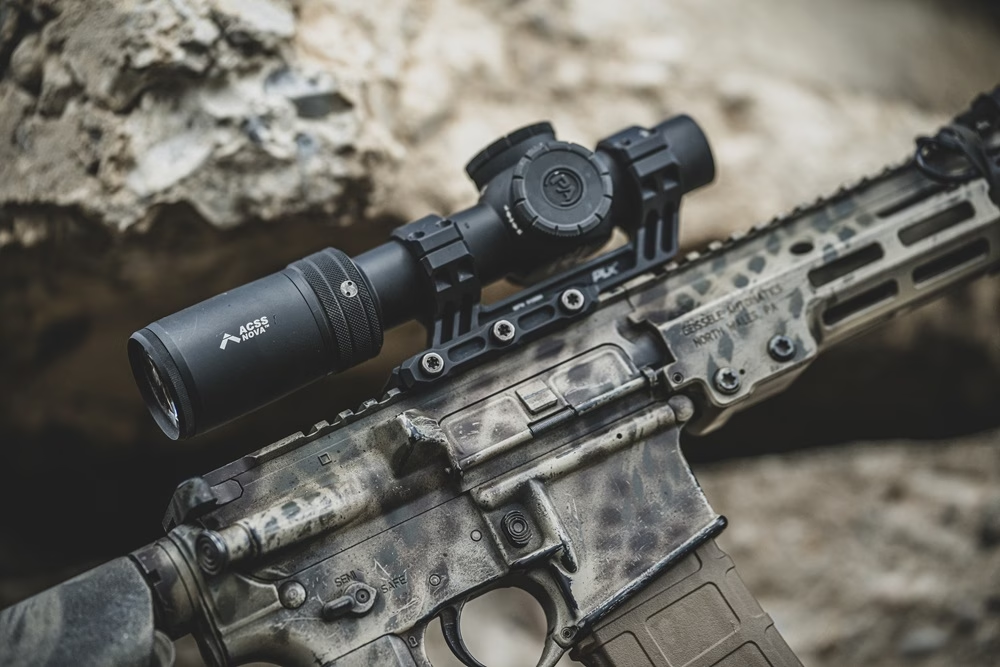
PLxC 1-8x24mm Rifle Scope
Constructed from an incredibly durable aluminum body, these optics were designed with professional use in mind, making them a solid choice for big game hunting. Weighing just under 17 ounces and measuring only 9.2 inches long, these compact optics come standard with premium Japanese ED Glass, SOS® (steel-on-steel) adjustable turrets, and they’re waterproof, shock resistant, and fog resistant. Plus, they’re available with several unique reticles. Although LPVOs aren’t generally seen as a go-to hunting scope, PLxC 1-8x rifle scopes are impressively powerful. Each one can range out to 800 yards while still being nearly as capable as a reflex sight at close range.
Depending on the model you choose, these optics can house the ACSS® Raptor, ACSS® Raptor G2, and the ACSS® Griffin reticle systems. The ACSS Raptor and Griffin reticles use a BDC- and MIL-based design, respectively. Being part of the ACSS® family of reticles, they both come standard with an assortment of windage holds and moving target leads, but the Raptor is calibrated specifically for 5.56 NATO and .308 Winchester, the Griffin uses a MIL-grid that’s compatible with multiple calibers. The Raptor G2 is one of the newest reticles designed for the new PLxC RDB scope, which uses an advanced micro-etched reflective grating on the reticle, giving it true Red Dot Bright® illumination. Also, they’re available in a first-focal plane (FFP) configuration.
Additionally, you can also opt for the ACSS® NOVA®, one of the most unique reticles offered by PAO. It has a unique fiber wire reticle design, so it’s only available in a second focal plane configuration—but rest assured, the PLxC 1-8×24 SFP Compact Rifle Scope is a more-than-viable scope choice for hunting. The ACSS NOVA is available in both a BDC configuration—calibrated for 5.56 NATO and .308 Winchester—and a MIL configuration, and like the FFP reticles above, they’re equipped with automatic ranging stadia that can range out to 800 yards. It is worth noting, however, that the MIL variant comes with added subtensions to compensate for wind or moving targets. Regardless, because they use fiber optic tubes, they have exceptionally bright center dots.
Being a professional grade optic, these LPVOs are ready for use in all conditions. Depending on the model, PLxC 1-8×24 LPVOs can vary in price, with them typically costing around $1,500 to upwards of $1,750, depending on the reticle. Still, there aren’t many optics that do it quite like the PLxC LPVO. The sheer adaptability they offer makes them a solid, do-all optic that’s fit for the range and the field.
EOTech
Despite being most well-known for their various holographic weapon sights, EOTech has stepped into the rifle scope space with the release of their VUDU scope line. Despite there being several optics in the VUDU line, as far as hunting is concerned, the VUDU 1-10x LPVO stands out as a solid hunting optic.
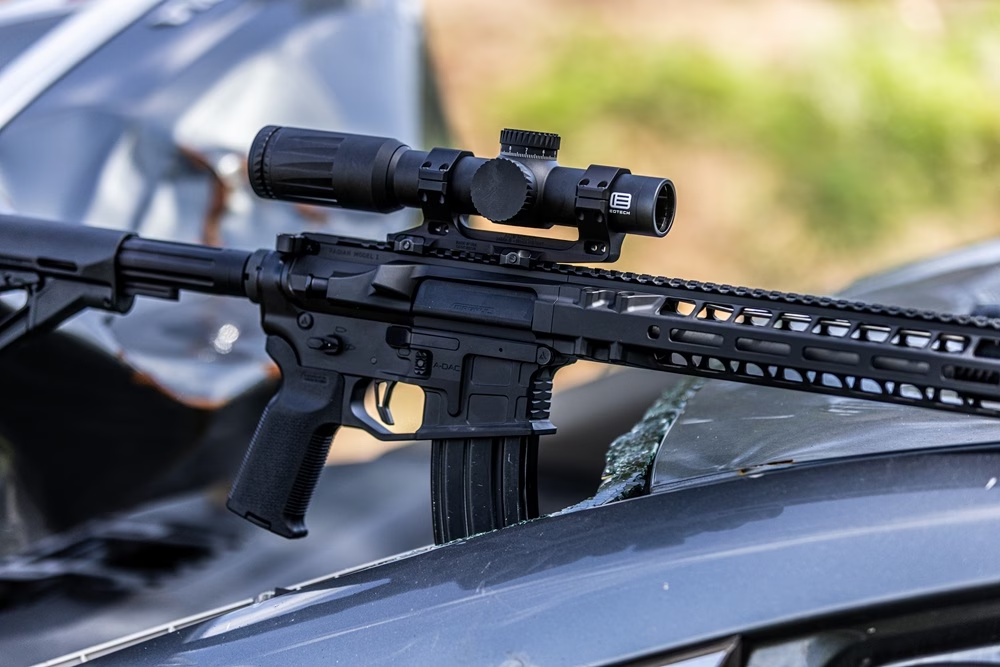
EOTech VUDU 1-10×28 FFP
The EOTech VUDU 1-10×28 FFP Rifle Scope is a versatile LPVO that offers an impressive number of features. Much like the PAO PLxC 1-8x, the VUDU 1-10x LPVO doesn’t immediately stand out as a hunting scope, but its capabilities make it great for the job. Using a solid aluminum construction, these optics come standard with low-profile windage and elevation turrets complete with a unique push/pull locking mechanism, high-quality glass, and an intuitive reticle designed to offer both close- and medium-range performance.
Housed within this optic is the SR5 MRAD reticle. At 1x magnification, it’s nearly as agile as a red dot sight, as the reticle’s outer Speed Ring—hence the “SR” in SR5—looks and performs strikingly like the iconic EOTech circle dot reticle found on their holographic sights. At 10x magnification, the SR5 MRAD reticle has a unique circle dot center aiming point, while the cross hairs have a series of MIL subtensions to compensate for wind and your target’s movement. And for shots at further distances, the SR5 MRAD reticle has a “Christmas Tree” style MIL grid, which gradually flares out to provide you with adequate holdover points to account for various ranges.
On its own, the VUDU 1-10x LPVO is a solid optic that’s perfect for hunting and other applications too. It’s also one of the more premium options in this list, with it being priced around $2,000. Still, if you’re looking for a capable optic with a smaller footprint, it’s definitely worth checking out.
Vortex Optics
Easily one of the most recognizable names in the industry, Vortex Optics has been at the forefront of optics manufacturing for years, honing their craft, and creating a lineup of several incredible rifle scopes. Among their various Vortex scopes available, one of their most popular is the Strike Eagle 5-25×56 rifle scope.
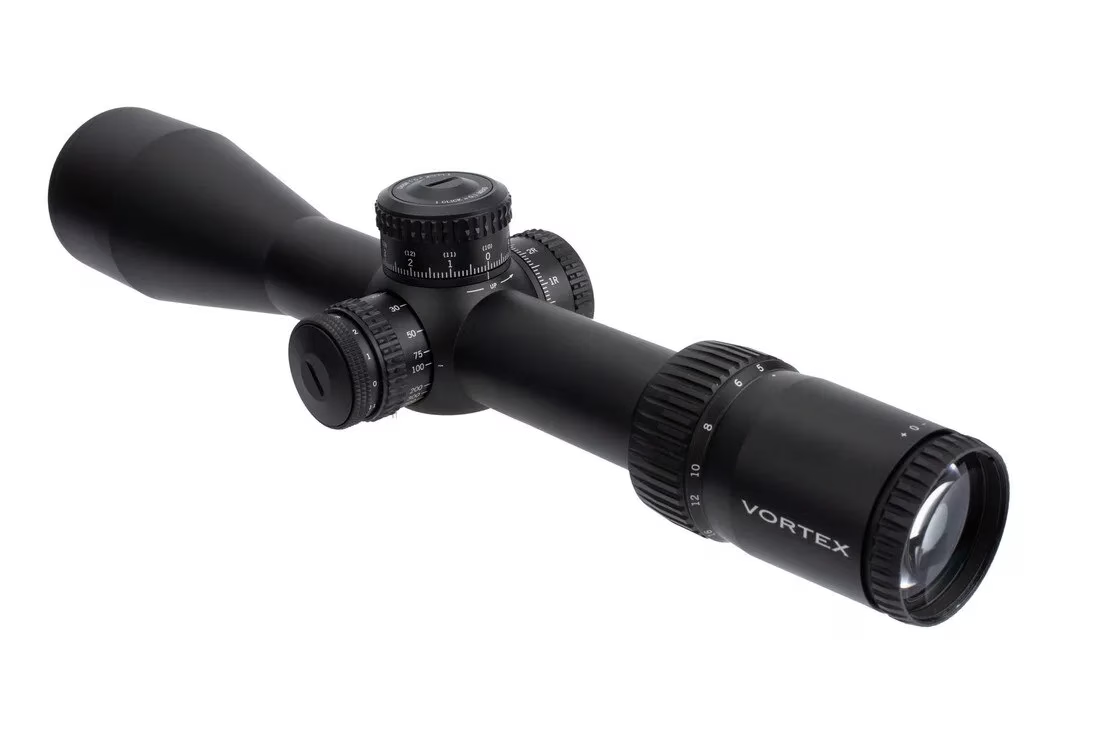
Vortex Strike Eagle
The Vortex Strike Eagle 5-25×56 rifle scope is widely considered Vortex Optics’ best scope for deer hunting. Although the Strike Eagle series is most associated with the Strike Eagle LPVO models, the 5-25x scope stands out as a solid high-power optic fit for all budgets. Strike Eagle 5-25x rifle scopes are built around a durable aluminum optic body, and they come equipped with Vortex’s ArmorTek protective coating, RevStop return to zero system, and locking turrets, making them ready for any environment.
Housed within this optic is the venerable EBR-7C MRAD reticle system. The Enhanced Battle Reticle has several notable features, including MIL subtensions on its crosshairs in addition to a full MIL grid. Being an MRAD reticle, it’s compatible with nearly every caliber and rifle platform, making it a solid hunting scope. And, if you’d prefer, these scopes are also available with an MOA reticle as well. It makes use of the same overall design, but as its name would suggest, it’s tailored for imperial measurements instead of metric ones.
Compared to the other optics mentioned above, the Strike Eagle 5-25x is one of the more budget-friendly choices. You can typically find these scopes priced around $800, and although they aren’t as compact as LPVOs, they pair exceptionally well with bolt-action rifles, and large caliber semi-autos.
SIG Sauer
SIG Sauer has been an avid producer of optics for quite some time, with their lineup consisting of several unique reflex sights and variable power optics. Among their rifle scope options, the TANGO DMR series easily stands out as a solid hunting scope.
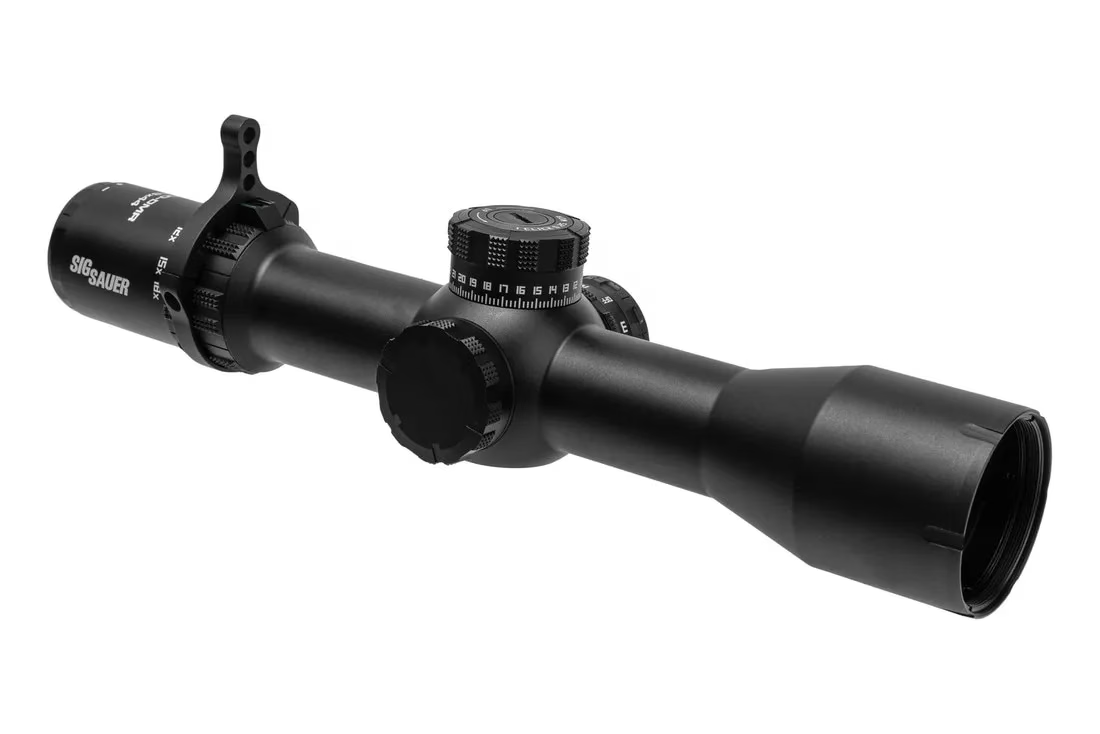
SIG Sauer TANGO DMR
The SIG Sauer TANGO DMR 3-18x44mm has garnered a reputation for being a ruggedly reliable rifle scope. Utilizing a rigid aluminum optic body, it’s ready for field use; it comes standard with low-profile windage turrets, a locking illumination control knob, and it’s been rigorously tested to ensure that it’s water-, shock-, and fog-proof.
As its name suggests, this optic is designed to offer capabilities that are befitting of a Designated Marksman Rifle (DMR), meaning it’s also perfect for big game hunting. It’s 3-18x magnification makes it capable of engaging targets out to around 1,000 yards with ease, and with its MOA Milling 2.0 reticle, it’s exceptionally versatile, offering a plethora MOA-based subtensions and ranging stadia on its crosshairs.
It’s critical to note that SIG’s TANGO optic line is one of their more premium ones, making this optic one of the more expensive offerings in this list. Typically, you can find these optics priced around $1,300.
NightForce
NightForce is a name that commands a high-level of prestige. Known for crafting some of the industry’s finest optic systems, they’re one of, if not, the most recognizable brands in the industry, and they offer a plethora of unique optic systems that are highly effective in a dedicated hunting capacity. Among them, their NX8 series optics stand tall.
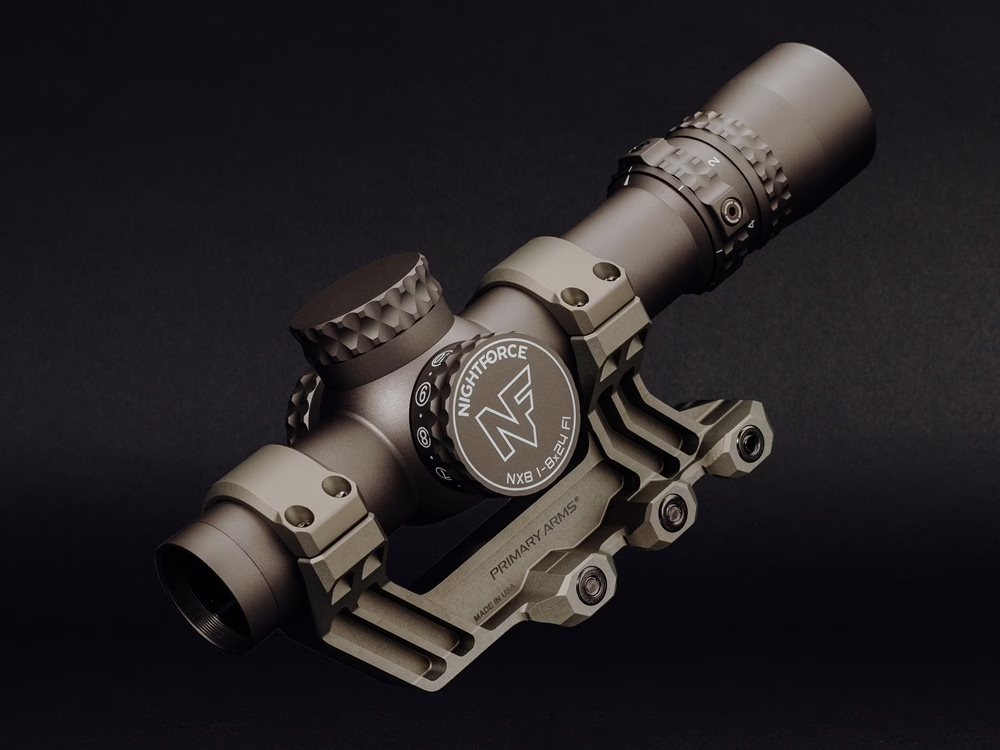
NX8 1-8x24mm
The NightForce NX8 1-8x24mm rifle scope is a top-tier LPVO that offers a level of adaptability that’s needed for more dynamic hunting scenarios. Being an LPVO, it excels in both close- and medium-range engagements, offering both close-range agility and precision at distance. This optic is packed with features that make it more-than-suitable for rough field conditions—its durable aluminum construction, high-quality glass, and enhanced windage and elevation turrets are capable of facing adverse conditions without compromise, while its illuminated reticle and finger-adjustable windage and elevation turrets allow for great visibility and ease-of-use.
The NX8 1-8 LPVO comes equipped with the FC-DMX reticle, which provides a bright center dot when at 1x magnification, and a segmented circle dot center aiming point, crosshairs with MIL subtensions, and a full MIL grid for more complex holds at 8x magnification. NightForce isn’t a budget brand by any means, so these optics are typically priced around $1,700 to $1,800. Select models can also come with various optic mounts, such as the Reptilia Corp AUS Mount, with these packages hovering around $2,000.
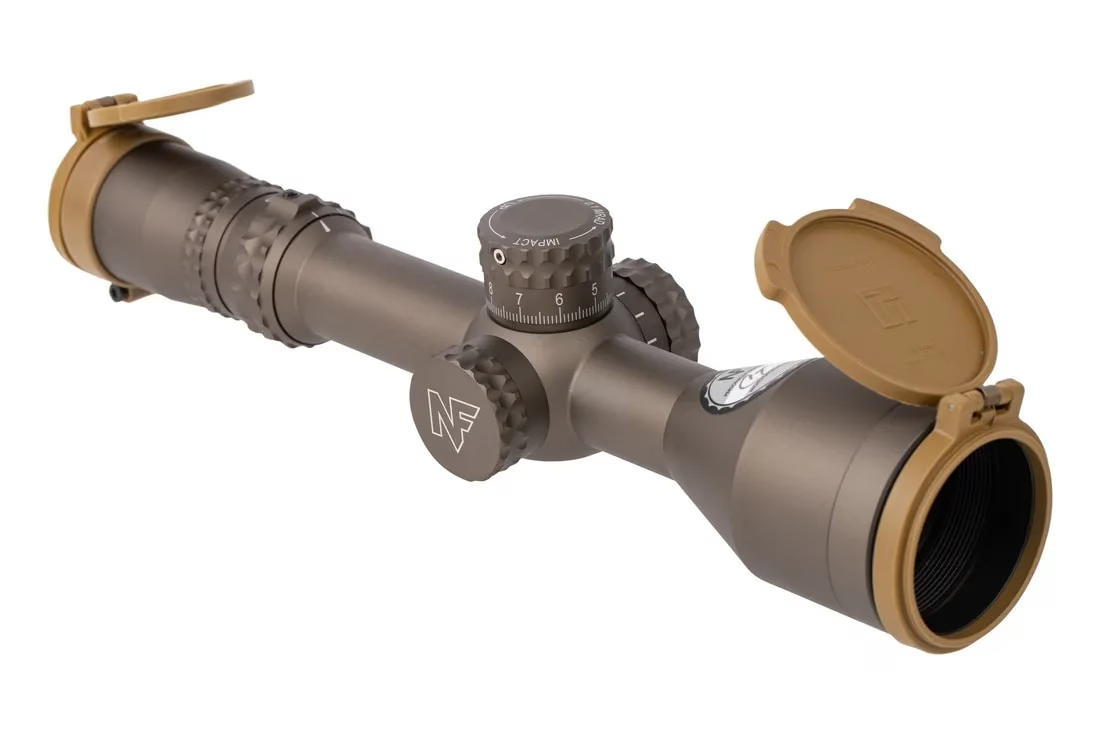
NX8 2.5-20x50mm
Another fantastic optic for hunting is the NightForce NX8 2.5-20x50mm rifle scope, an optic with impressive close- and long-range capabilities. It has all the same features as the NX8 LPVO mentioned above, albeit in a larger size to accommodate its greater magnification range. Many other MPVOs don’t typically have a magnification range that goes much further below 3x magnification. And while 2.5x magnification doesn’t sound all that impressive on paper, it puts you within a nice visual sweet spot that offers solid agility at close range, while still being able to go the distance at 20x magnification.
To make the most out of this dynamic magnification range, it’s equipped with the MIL-XT™ reticle. Its crosshairs are complete with a plethora of you MIL subtensions, spaced evenly at .2 MILs apart. And like the NX8 LPVO’s reticle, it has a full MIL grid for complex holds, though being a 20x capable optic, it has a much more extensive MIL grid for shots at even greater distances. As it stands currently, the NightForce NX8 2.5-20x rifle scope is one of the top rifle scope options on the market. As such, it’s typically priced around $2,000.
Which Optic Is Best?
To put it bluntly, it’s impossible to declare one option as the best rifle scope for hunting. Each of the optics mentioned above are incredibly useful when hunting, so it’s important to realize that each one offers its own distinct advantages. As such, choosing one ultimately comes down to finding the one that best aligns with your own needs and preferences.
If you’re primarily going to be shooting at distances within 250 to 300 yards, LPVOs like the Primary Arms Optics PLxC 1-8, EOTECH VUDU 1-10, and the Nightforce NX8 1-8 are all solid options, while also being capable of ranging out farther if needed. If you’re planning to hunt at distances beyond 300 yards or even as far 500 to 600+ yards, any of the MPVO or HPVO offerings mentioned above are going to be your best bet, as they have the magnification ranges and reticles needed for making accurate shots at such distances.
Conclusion
With hunting season right around the corner, there’s no better time than now to start gearing up on all the best hunting essentials, including a new optic for your rifle. The right rifle scope can elevate your rifle’s performance, allowing you to get a better picture of your target, while also providing you with critical ranging information to make sure you can effectively and humanely dispatch your target when you’re in the field.
With optics, there’s a lot to consider when choosing an optic for your rifle. Factors such as its magnification range, reticle, construction, as well as the environment you’ll be traversing in all go a long way in determining which optic is going to be the best one for you. Because of this, we highly recommend researching all the options available to you.
So long as you do, you’ll be ready for your next hunting trip. Before heading out though, it’s always a good idea to double check that you’re stocked up on all the essentials you’ll need when out in the field. If you haven’t already, we recommend checking out our article, “What should you put in your field dressing kit?” to make sure you have everything you need.
